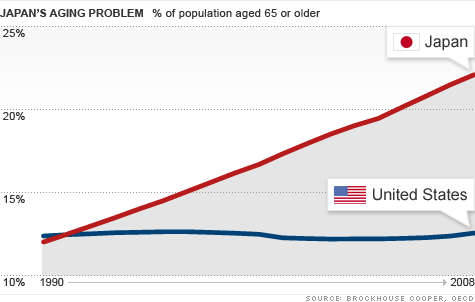E
Edmund Scanlan
AP Human Geography 🚜
320 resourcesSee Units
A greying population can be a sign of trouble:
A number of countries have a high percentage of people that are in or near retirement age (60 or older). This can happen for a number of reasons and have some serious consequences in those regions.

Countries that are in stages four and five of the demographic transition model have lower birth rates, but higher death rates than countries in stages two and three. Less people are in their childbearing years. These countries tend to have more women who are educated. For these reasons, the birth rates are lower.
With better health care more people are living into their 70s and 80s, but this causes the death rate to rise, because of the large number of older people. When these countries are in stage five of the DTM, they have a negative natural increase rate, which means their populations are decreasing.
Countries that are in stages four and five are more developed and therefore have long life expectancies.

Political Consequences
There are political consequences because older people tend to vote more. They also are more concerned about health care issues, because it more directly affects them. With the older population voting more, the policies that the government puts in place would more likely apply to this age group.
Therefore, politicians need to garner support from older people, handle issues like health care more directly, and possibly even have more elderly in office.
Social Consequences
There are also social consequences. Besides health care, things like housing for the older generations need to be addressed. Countries with older populations need to invest in retirement homes and have more people to help care for the elderly.
Family compositions can change, too, as sons and daughters need to help pay for and/or care for their older parents. This can lead to severe economic consequences as well. The family structures can change as well, as older individuals will often live by themselves or in group homes.
Economic Consequences
Lastly, there are economic consequences. With more older people and lower birth rates, you have fewer people in the workforce. This can lead to lower production, which will lead to less money being made. That is doubly bad when you consider how many people will have to use part of that money to care for elderly family members.
With the government spending more money on taking care of older people and healthcare, less money will be spent in other areas - education, technology, innovation, arts, etc.
Social security and pension systems are also affected as there is more pressure put on them. This can lead to a lot of debates on the sustainability of these systems and the possible need for reform.
🎥 Watch: AP HUG - Population Pyramids
Browse Study Guides By Unit
🗺Unit 1 – Thinking Geographically
👪Unit 2 – Population & Migration
🕌Unit 3 – Cultural Geography
🗳Unit 4 – Political Geography
👨🌾Unit 5 – Agriculture & Rural Land-Use
🌇Unit 6 – Cities & Urban Land-Use
💸Unit 7 – Industrial & Economic Development
🧐Exam Skills
📚Study Tools

Fiveable
Resources
© 2025 Fiveable Inc. All rights reserved.